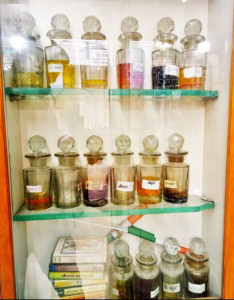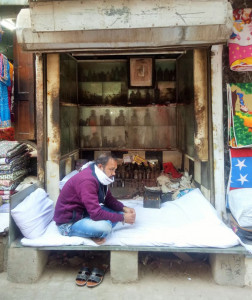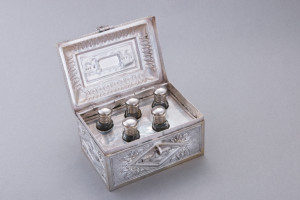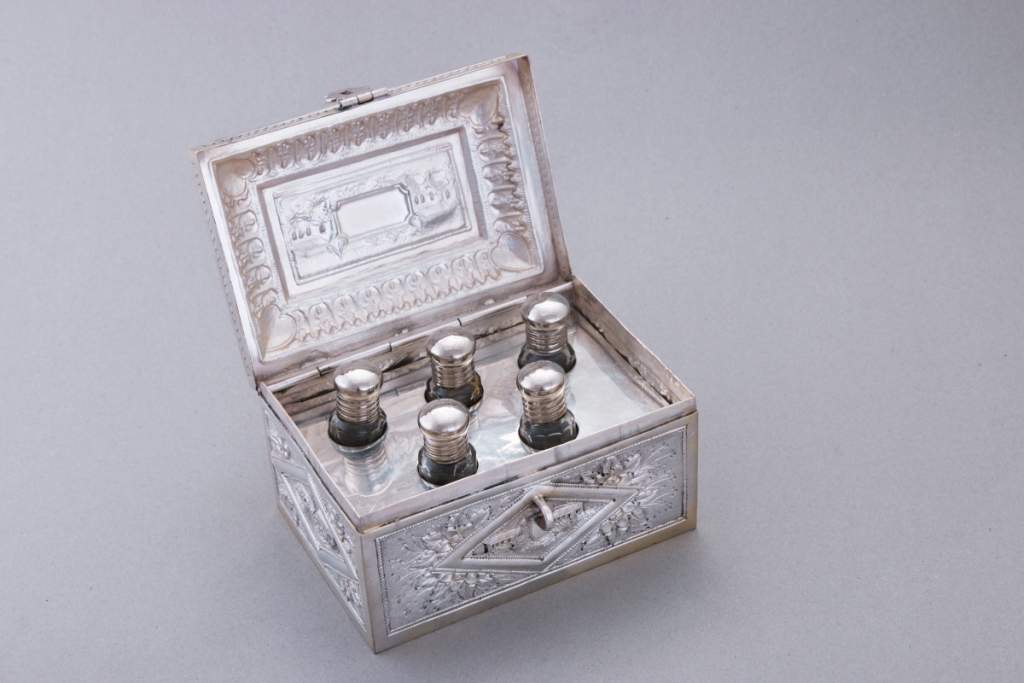
Bottled Goodness: Attar and Attar Daans
Posted by Admin on Wednesday, March 17th, 2021
In a world emphasizing on beauty and cosmetics, this article explores the humble, age-old traditional ‘Attar’, and several practices and beliefs associated with the olfactory sense, or the sense of smell. It looks at its ability to lure or ward off good or bad, to entice and appease, as also the immense potential it has in terms of aiding health.
Meaning of the term ‘Attar’
In the larger Indian context, perfume is referred to as ‘Attar.’ The word has a Persian origin with ‘Atr’ meaning fragrance.
Fragrant beginnings: Historical contexts and references
Literary sources suggest that the art of making perfume was learned quite early, in the history of the Indian subcontinent, and its knowledge passed down from generation to generation amongst a selected few. It has evolved but has retained its essence.
The expertise in scents and fragrance goes back to the Vedic times. The Rig Veda is the oldest known text in India. It refers to a Vedic ritual of a fire sacrifice, to appease the gods. Offerings of various kinds were submitted to the holy fire including the fragrant Sandalwood, and a resin called Guggul, obtained from the tree Mukul Myrrh. The raging fire of the yajna would consume the offerings, releasing fragrant smoke that would reach high into the sky, to the gods. In addition, it also suggests an understanding of good scents and bad scents. In all likelihood, the concept of perfume would perhaps date back to the Vedic Age.
Process
Unlike the alcohol based perfumes that are today available in the market, perfumes were originally non-alcoholic in form; pure and natural. This was done from a spiritual and religious point of view, a practice that continues till date amongst some communities.
A distillation process follows through to convert raw materials including the fragrant item, e.g. a flower, or wood, and water, into the end product. The ingredients are boiled in an air tight vessel, resulting in release of steam. The fragrant steam condenses, and is mixed with a base essential oil. Take for example Rose extract or Rose water; it is produced in this manner. These perfumes are ideally stored in air tight containers.
A whiff of luxury
Attar was always considered an item of luxury; some of them were known to be very expensive and difficult to process. In pre-independent India, perfumes or Attars were used by royalty, and was considered to be a status symbol. Those that could afford to shell out a bit of their savings on this luxury treated it with extreme caution. Till date, some would prefer to purchase these fragrant concoctions, smeared on a cotton bud, and kept for a reuse, at the back of the ear.
The demand could vary; local Attar dealers in Rajasthan state that customer requests range from 10ml bottles to 5 litre containers of the precious liquid.
Amongst royal households, there existed the practice of storing Attar in containers known as Attar Daan. A provision was made to keep the Attars for the different seasons separate, to make the process of application full of ease, and to avoid wrong application. These Attar Daans could be of crystal-cut glass, or regular glass and even silver. Such types of Attar Daan can be seen in the Silver Gallery, The City Palace Museum, Udaipur.
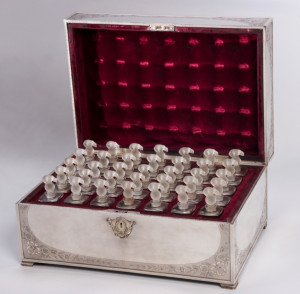
Silver Attar/ perfume box with crystal-cut bottles | René Lalique | Silver, glass, cloth, wood |1930 CE | CPMU 2014.29.0167
The Attar Daans could be of varying sizes. This René Lalique make is a large sized box with as many as 35 pieces. Lalique was a French designer of decorative arts. Each of the bottles, with its crystal-cut ‘circus bear’ shaped stoppers, reflects his finesse. This beautiful piece is a royal heirloom; taken as trousseau by Princess Kailash Kumari Devi of Patiala when she married into the royal house of Patna Balangir, Odisha. Passed down through the generations, it made its way into Udaipur, and subsequently the Museum’s collection, through Princess Nivritti Kumari Singh Deo when she married into the Mewar Family.
In contrast to the Lalique Attar Daan, this is a smaller piece, with five bottles to hold the perfume. Each of these is held sufficiently apart, to perhaps efficiently differentiate between the Attars. Also notice how each of the boxes neatly secure the bottles, to avoid any mishaps or shaking of the perfumes. The small size of this Attar Daan makes its highly portable and convenient; it could be easily closed and carried along!
The ‘Good’ Scents: Value loaded
Perfume or Attar is known to have spiritual significance as also tremendous medicinal importance. Considering the nature of the production and raw materials used, the ‘non-alcoholic’, chemical and toxin free, nature based Attar or perfume is used in health related treatments. In a combination with the essential oil, either dilutions with water or direct applications are made on the affected area, as per the health issue. Lemon grass, peppermint, spearmint, saffron, lavender, etc. are known to be very beneficial from medical point of view. Health issues such as headaches, body pain, nausea and others can be treated with appropriate applications of Attar, mixed with essential oils.
A Seasonal Classification
There has been an understanding of the nature of the raw materials, and the associated health issues, amongst Attar makers. With a rather scientific approach, traditionally, Attar is classified into 3 different categories, in India. These are based on the seasons, i.e. perfumes or Attars for the monsoons, summers and winters.
Monsoon Special
The perfumes or Attars that are custom made for the monsoons capture the season in all its essence. The sweet scent of flowers such Chaitri gulab, Mogra, Kevda, Pushpendra and others are efficiently recreated as perfumes.
The Chaitri gulab is an extremely fragrant type of Rose that is widely available in a village Khamnor (Rajsamand), Rajasthan, renowned for the battleground of Haldighati. It blooms in the month of Chaitra (March-April), as per the Hindu calendar, which is from where it gets its name. While most Attar dealers will suggest its year – round use, followers of the Pustimarg Sect of Hinduism recommend its usage only during the monsoons.
The monsoon magic is almost incomplete without the aroma of the wet earth, post the rains. This type of perfume traces back to the region of Kannauj in the Indian state of Uttar Pradesh, where it originated. Quite a mood changer it is!
Winter Special
Come winters and a hoard of health related issues crop up, with a sudden drop in atmospheric temperature. Cold, cough and heavy heads are common ailments; the winter special Attars work like a medicine. In the Mewar region of Rajasthan particularly, they are used to warm the body. In its temples where Lord Krishna is worshipped in his child form, such a practice is seen, to ensure the deity’s health. The perfumes are prepared using plant based ingredients such as Kesar, Shamama, Heena, Amber, Sondha, etc. or animal based ones such as Kasturi, during different time periods in the winter season.
The high priced Kesar, commonly known as Saffron, is sourced from the cold region of the Himalaya Mountains; the only region where it is available. While Kesar requires extreme cold temperatures to thrive, the Attar produced from it is known to provide warmth, and which can be used only in the winters. It is often used in combination with massage oils like mustard and coconut, and applied especially on aged persons, and in postnatal care of women. Because of its high price, this Attar is an item of luxury, frequently used amongst royalty, often on a day to day basis.
Equally rare and precious, and an item of luxury used by royals is the Kasturi Attar, also known as Musk. Its sourcing technique makes it so precious. The main ingredient for this Attar is obtained from the navel of a rare deer called Kasturi Mrig, found in the cold forests of the Himalayas. The soothing fragrance of the Kasturi Attar is ranked first amongst Attars of animal origin.
Summer Special
Summers are known to be scorching hot, especially in the arid desert regions of Rajasthan. In such times, cooling is most desired. For this, plant based ingredients such as Chandan, Chameli, Gulab, Parijaat, Oodh, Khus are used in Attar preparations. They are extremely mild in fragrance and soothing, and help ease health related issues like nausea and skin allergies that are peculiar to summers.
The Parijaat or the night flowering jasmine, is known to cure mild fevers, open wounds, distress, joint pains and swollen muscles, and it’s therefore popularly used even as a perfume.
Considered sacred, and very auspicious, Chandan or sandalwood and its Attar are utilized as an offering to Shiva, as a coolant, in summers.
Deos or Attars: This or that?
The new world has largely lost touch with its former self. While the Attar business continues to steadily grow, and yet retain its true essence; one of closeness to nature and of purity, its patrons are often limited to a selected few. The markets are flooded by gas or alcohol based Deos. Not only do they cause harm to the skin by way of irritation and darkening, they are also known to be highly flammable. The value loaded Attar is a winner no doubt. It is only a matter of time before we go back to our old ways!
- Neeraj Soni,
Visitor Liaison Executive

